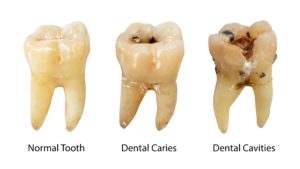Cavities: Signs, Diagnosis and Treatment

Your teeth are one of the essential parts of your body. Not only do they help you eat and speak, but they also have a significant impact on your appearance. Because they are constantly used and exposed to so much wear and tear, it is not uncommon for issues to arise with your teeth—one of the most common dental problems that a person experience is cavities. Most people will have a cavity at some point in their life. Cavities, which are nothing more than decay in a tooth, are one of the most common disorders, and their damage can range from mild to moderate to severe. All cavities, even the most brutal, start small. When they are left untreated, they can become massive problems, requiring extensive and painful repair, such as a root canal and even the loss of the tooth.
With the proper knowledge and proper care, you can ensure that you don’t have to suffer the extreme discomfort and extensive dental work required by a massive cavity. Here is a look at what you need to know about dental cavities.
A Comprehensive Look at Cavities
As previously mentioned, cavities are one of the most common conditions people experience. Cavities are so common that they are the number one cause of tooth loss in young people.
Causes
Bacteria is the cause of tooth decay. It is not uncommon to find bacteria in the mouth. It is normal. This bacteria changes the food you consume into acid, which combines with your salvia and sticks to the teeth. This is known as plaque, and if it is not removed, it begins to decay the teeth.
Signs and Symptoms
When cavities begin to form, they do not have symptoms. In other words, they do not hurt. However, as the decay progresses, symptoms will start to present themselves.
These symptoms include:
- Aches or pains in the tooth are affected, especially when eating something hot, cold, or sweet.
- Visual signs of tooth decay include visible, dark-colored holes in the teeth.
Detecting Tooth Decay
Cavities can be detected in their early stages, before they progress, during a routine dental exam. X-rays of the teeth are taken, showing cavities before they become visible to the naked eye. Your dentist will also examine your teeth with a unique tool to look for signs of pitting or softness on the surface of the teeth.
Treatment For Cavities
When tooth decay is detected, it needs to be treated as soon as possible to avoid further damage. If caught early enough, this treatment will involve the filling of the cavities. If the decay has progressed too far, a crown or even a root canal will be needed.
Repair this decay with a filing begins with the dentist removing the decayed tooth material with a drill. The removed material is then replaced with a material such as gold, porcelain, silver alloy, or composite resin. This material will prevent further damage from occurring. A crown is used when extensive decay begins, and there is little structure of the left tooth. A root canal is used when the decay has damaged or killed the root of the tooth. With a root canal, the tooth’s center is removed, and the nerve and the root are filled with a sealing material. The tooth is then sealed, and a crown is installed.
Trending Health Topics
- ADHD
- Allergies
- Arthritis
- Bipolar Disorder
- Bunions
- Car Accidents
- Chron's Disease
- Common Cold
- COPD
- Depression
- Dry Skin
- Dry throat
- Eczema
- Fungal Infection
- GERD
- HIV/AIDS
- Hypertension
- Irritable Bowel Syndrome (IBS)
- Multiple Sclerosis
- Osteoarthritis
- Psoriasis
- Rheumatoid Arthritis
- Skin Disorders
- strep throat
- Type 2 Diabetes
- Uncategorized